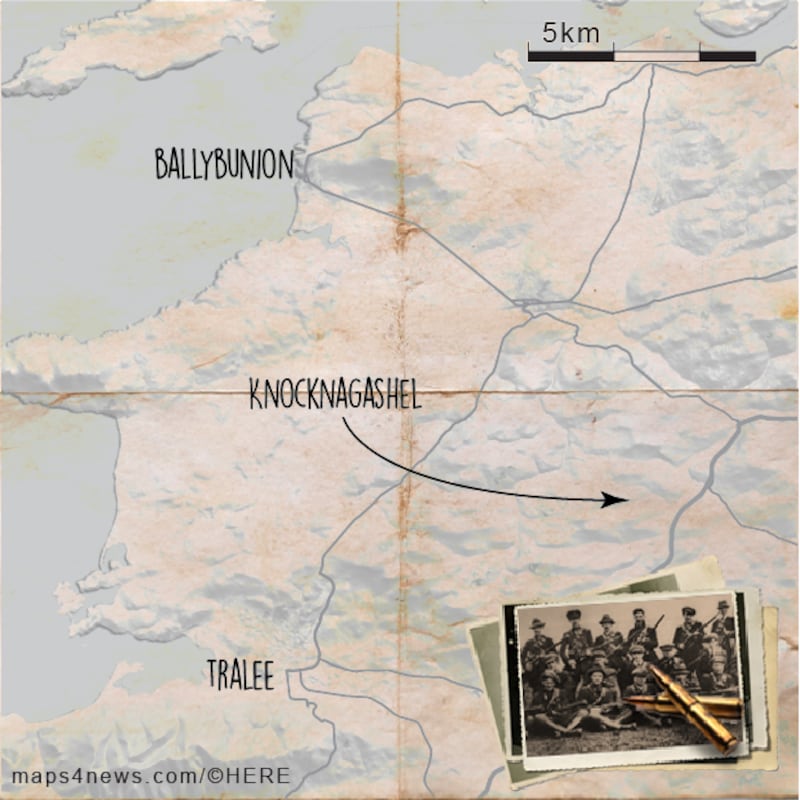[ Read the full collection hereOpens in new window ]
County: Kerry
Incident: Ambush at Rathmore
Date: May 4th, 1921
Fatalities: 8
The IRA in Kerry shot a Traveller and used his body as a decoy to lure the Black and Tans into an ambush in one of the largest engagements in the War of Independence.
On April 27th, 1921, men from the 2nd Kerry Brigade arrested Tom O’Sullivan, known as ‘Old Tom’, a Traveller and itinerant singer of about 80 who they suspected as having given information to the Black and Tans.
His fate was sealed when two British army deserters who were captured by the IRA stated that O'Sullivan was a regular visitor to the barracks in Rathmore near the Kerry border.
"After thinking things over, I decided that when I executed Old Tom I would use his body as bait in an attempt to draw some of the garrison out of Rathmore barracks," Manus Moynihan, the captain of the Rathmore company (5th battalion, 2 Kerry Brigade) told the Bureau of Military History.
The site that was chosen was a bog road near the village of Rathmore, which intersected with a boreen where the roads bend around and where there were hedges for cover.
O’Sullivan was executed on May 4th and his body laid as a decoy for a passing Black and Tans patrol, according to the account given by the Rathmore company in the Brigade Activity Reports.

The ambush took place that morning and eight Black and Tans were killed by 50 IRA men laying in wait. They later seized a large quantity of arms, including eight rifles with 800 rounds.
Three of the Black and Tans fell into a drain and their bodies were dragged out to be searched for ammunition.
The IRA in Kerry were particularly ruthless at executing people they believed were spies.
James Kane, a fisheries protection officer in Co Kerry, was executed on June 16th, 1921, on suspicion that he gave his former RIC colleagues details of eight IRA men who were involved in the shooting dead of the constabulary's divisional commander.
Det-Insp Tobias O'Sullivan was shot dead on January 20th, 1921, outside Listowel Barracks in Co Kerry. Some time later, men from the 6th Battalion, Kerry North Brigade, kidnapped Kane.
Executed
After a prolonged period of interrogation, he was executed on June 16th, 1921. His body was left by the side of the road with a note, “Convicted spy. Let others beware. IRA”.
Before he died, Kane composed a letter to his family which is in the Brigade Activity Reports of 1 Kerry Brigade. The letter is addressed to his children, one of whom is said to have cried out as the coffin was lowered into the ground, “Daddy, Daddy”.
It beings: “My dear children, I am condemned [to] die. I had the priest today, thank God. I give you all my blessing and pray God may protect you all. Pray for me and get some masses said for me.”
Kerry saw some of the worst fighting of the Civil War. Many of the IRA in the county went over to the anti-Treaty side. The fighting was at its worst in March 1923 when five National Army soldiers were killed in an ambush at Knocknagoshel.
That attacked occurred on March 6th. A day later, nine Republican prisoners were taken to a crossroads at Ballyseedy outside Tralee, tied to a landmine and blown up.
There was one survivor – Stephen Fuller, who went on to become a Fianna Fáil TD.
He was blown into a ditch and remained free because the soldiers thought everyone had been killed.
Fuller was later found severely burned, with grit under his skin, and received the maximum £150 pension when Fianna Fáil came to power in 1932.
In his application for a military pension, he gave a graphic account of what happened: “I was tied up in three places. The explosion cut all the rope . . . It was about two feet from the mine – it would not be three feet. All the rest were killed – eight of them.’’







